Best running shoes for supination: Find the perfect fit for your feet
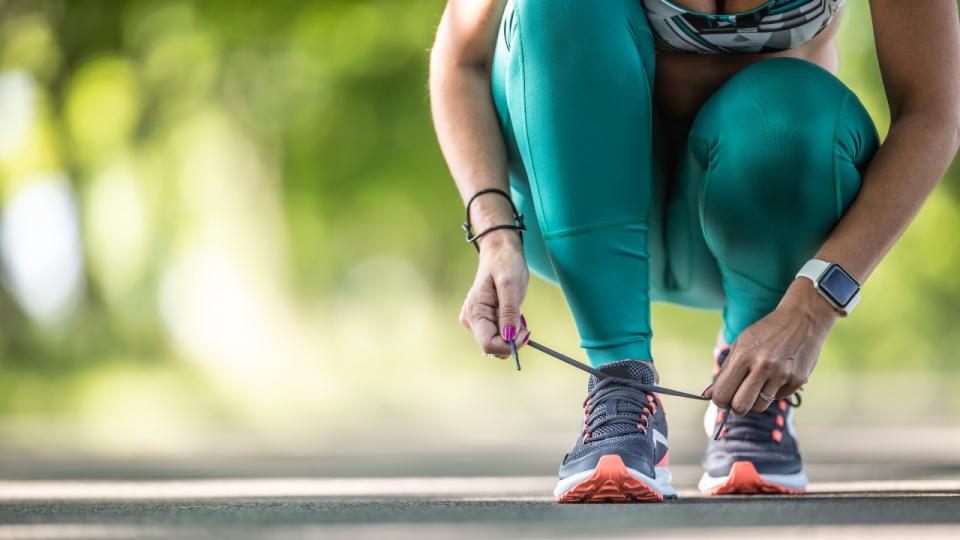
The best running shoes for supination can save you a lot of pain. Supination refers to the tendency to run with your weight landing on the outer edge of your foot, which means you are less able to absorb the impact of each stride. If it’s not dealt with, supination can lead to an increased risk of injury for runners, so investing in the right shoes is vital, whether you’re running on roads, trails, or one of the best treadmills.
What makes running shoes for supination different to other models? To find out, we spoke to musculoskeletal podiatrist Anne-Marie O’Connor. She told Live Science that “Anything too flexible or soft (not reactive enough) will lead to early fatigue on the outer border of the outsole – then the danger of injuries will increase. A lower offset (or drop) is advisable to aid a fuller foot contact and the thicker midsole of a maximalist trainer is ideal. This will help with the midfoot advised running technique and also aid shock attenuation.” You can read more about running technique and advice in our guide on how to run properly.
If you know you are a supinated runner or are looking for shoes with extra support to start your running journey, we’ve got you covered. We’ve tried and tested a wide selection of running shoes for supination to present you with the very best options available to buy right now.
Best running shoes for supination
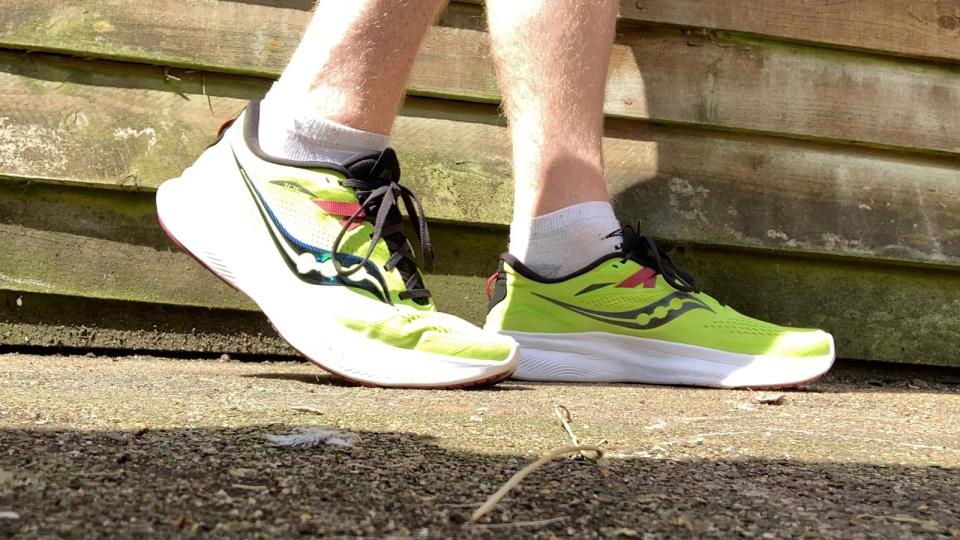
1. Saucony Ride 15
Best running shoe for supination
Weight: 8.8oz / 249g | Drop: 8mm | Terrain: Road | Category: Neutral
Plenty of cushioning
Lightweight and breathable
Flared midsole for stability
Signs of wear on outsole after 30km
Not a fast shoe
It’s for good reason that the Saucony Ride 15 is our top-rated running shoe for supination. It has ample cushioning courtesy of its PWRRUN foam sole and plush PWRRUN+ insole, while also providing plenty of support through raised sidewalls. The midsole extends laterally or 'flares' beyond the forefoot and heel of the upper to provide a wide, stable base that encourages you to adopt a neutral stride, and straps wrap around the side of the feet to lock them securely into place.
We found these running shoes were second-to-none when it came to comfort, with our knees feeling fresher post-run. And, despite the generous amount of cushioning and the lightly padded heel, they’re still responsive and light – ideal if you want to push the pace on a middle-distance run.
Don’t expect the elasticity of a racing shoe, as these are designed as an everyday sneaker for regular runners. But, if you’re after a versatile shoe to take you through everything from fast 10Ks to easy kilometers, these are more reactive than most of their direct competitors.
To top things off, they fit true-to-size and provide premium comfort out-the-box, leaving our heels blissfully blister free. What’s not to like?
Read our full Saucony Ride 15 review
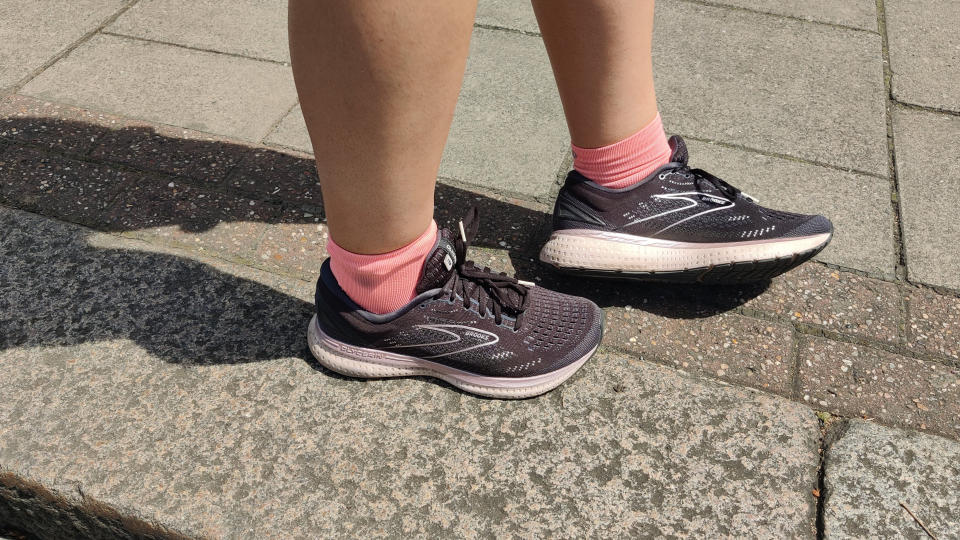
2. Brooks Glycerin 19
Best for newcomers
Weight: 10.2oz / 289g | Drop: 10mm | Terrain: Road | Category: Neutral
Cushioned support
Smooth and stable ride
Great for steady mileage
Size runs small
Achilles discomfort to begin with
Not designed for speed
It was a tight-run race for second place in our round-up, with three pairs tied-up with commendable four-star ratings.
The Brooks Glycerin 19 is the first of this esteemed trio to feature, offering a pillowy and comfortable ride with its lofty 31mm EVA foam stack. This generous support system does mean they don’t feel as reactive as race-day runners like the Nike ZoomX Vaporfly Next%, but that’s not their modus operandi.
Instead, they prioritize comfort over performance, qualifying them as a solid everyday sneaker for seasoned athletes racking up easy kilometers and slower-paced sessions. We also think they’re a great option for fledgling striders taking their first steps into the world of distance-running, who will want more forgiving footwear. And, with our tester having worn the Glycerin 19 for all 43.195km of their fifth marathon, we can safely say their cushioning won’t let you down.
They offer a more secure fit on the top of the foot than their predecessor, the Glycerin 18, with a shallower toe box providing greater stability. This does, however, mean the shoes fit quite tightly, so we recommend buying at least half (if not a whole) size up from your regular sneaker order.
Another feature we liked on the Glycerin 19 was the option to buy a standard or GTS (go-to-support) version, with the latter designed for those whose feet collapse inwards (pronate) when they run. The GTS shoes have denser sections of foam added to the sidewalls to prevent this by providing better ankle, knee and hip support, reducing the chance of injury.
They take a bit of breaking in before you can enjoy blister-free long runs, but the comfort you’ll have after this teething period is worth the wait.
Read our full Brooks Glycerin 19 review
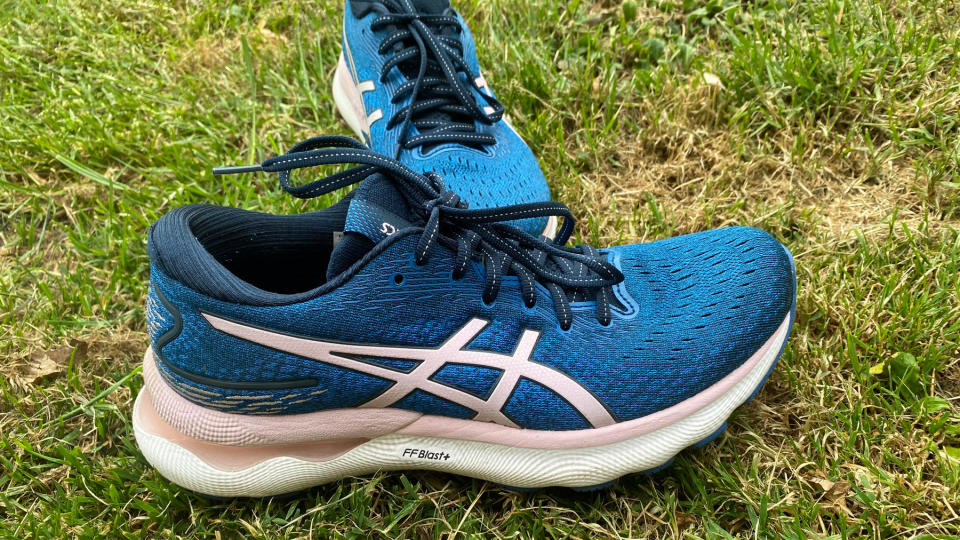
3. ASICS Gel Nimbus 24
Best for fast runs
Weight: 10.2oz / 289g | Drop: 13mm | Terrain: Road | Category: Neutral
Comfortable midsole
Good all-rounder
Breathable and flexible upper
Grip could be better
Lighter options available
Large drop better for heel strikers
The Asics Gel Nimbus 24 has a high drop (13mm for women and 10mm for men) that will suit heel strikers.
Asics also says its new FF Blast+ foam midsole is lighter, softer and bouncier than those used on previous models, and we’d be inclined to agree. We found it felt suitably flexible, allowing for a natural heel-to-toe transition, and had plenty of energy to offer. This reactive ride makes it the best neutral running shoe we tested for putting your foot down and upping the pace.
It’s shed some weight since its predecessor, the Gel Nimbus 23, and we liked the slimline feel of the newer shoe. It fits true-to-size, too, which is always a weight off when deciding what size to go while buying online.
The Gel Nimbus 24 also benefits from Asics’ Trusstic technology in the midsole. This is designed to flex safely under a neutral stride, but becomes rigid if the arch of the foot rolls excessively. We think this is a good compromise for runners who want added support, without the inclusion of less subtle stability features, like a medial post.
Overall, we think the Asics Gel Nimbus 24 is a great daily sneaker that caters to runners of all abilities. It’s comfortable, able to deliver on relaxed and fast-paced runs, and has clever stability features to promote a neutral stride.
Read our full ASCIS Gel Nimbus 24 review
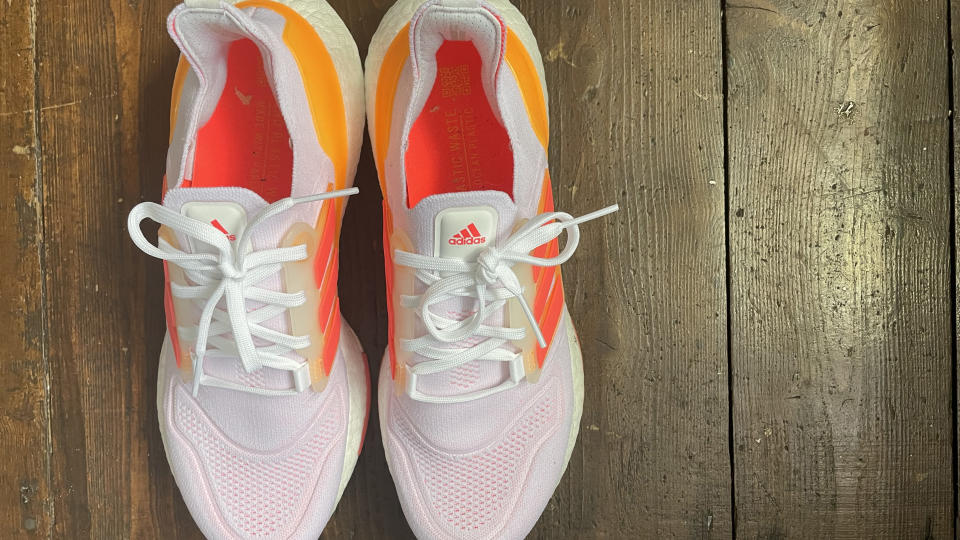
4. Adidas Ultraboost 22
Best for women
Weight: 11.8oz / 333g | Drop: 10mm | Terrain: Road | Category: Neutral
Out-the-box comfort
More responsive than previous models
Not a fast shoe for racing
Toe box is too snug
Unlike many running shoes on the market, the adidas Ultraboost 22 has been designed for women – rather than just being a shrunken-down version of a men’s shoe. Drawing from an enormous data set of more than one million feet, a female Adidas team found distinct differences between male and female feet, with women on average displaying a thinner heel and shorter instep. So, it has adjusted the design accordingly.
Our tester approved the changes, finding this latest iteration of the Ultraboost series felt snug and form-fitting, without ever becoming uncomfortably tight.
The Continental rubber outsole offers brilliant grip, too – after all, if it’s good enough for tires, shoe tread should be a walk (or should we say jog) in the park. And the shoes are also among the cream of the crop when it comes to cushioning, with the Adidas Boost foam providing a soft, bouncy ride. You can feel the 22mm of cushioning in the heel, and the 10mm drop helps your foot move through the heel-to-toe transition smoothly.
What the adidas Ultraboost 24 isn’t is a fast shoe. While we found the cushioning soft and comfortable, we didn’t get much energy return from them. Instead, this pair is best kept for longer distances and easy runs – something they do brilliantly.
Read our full adidas Ultraboost 22 review

5. Nike Air Zoom Structure 24
Best for versatility
Weight: 11oz / 312g | Drop: 8mm | Terrain: Road | Category: Neutral
Versatile
Out-the-box comfort
Supportive with a wide, stable midsole
Lumpy forefoot
On the heavier side
There’s a lot to like about the Nike Air Zoom Structure 24: they’re a neutral running shoe with ample cushioning to keep your joints feeling fresh on mid-long distance runs and have plenty of padding around the heel to provide a plush ride. This padding increases the weight of the shoe to a far-from-sprightly 11oz/312g, so we found they didn’t feel nimble enough for faster runs. But, as an everyday shoe for longer distances and easy kilometers, they performed admirably.
The midsole rises around the sides of the foot, particularly the medial arch, to prevent pronation and supination, and the Dynamic Fit lacing system wrapped effectively around our feet to lock them into place, leaving us feeling supported.
The Air Zoom unit in the forefoot of the midsole may split opinion. Designed to offer a more responsive run, we found it felt somewhat lumpy. And, while this wasn’t overly noticeable and didn’t impact our running performance, it did bring the shoe’s overall comfort score down.
What did earn the Structure 24 brownie points was its versatility. While shorter runs and speedwork aren’t its strong points, nigh on everything else is; from distance sessions to recovery runs to easy kilometers. We even found ourselves donning them for everyday wear, thanks to their appealingly minimalist monochrome design.
So, if it’s a jack-of-all-trades you’re after, look no further.
Read our full Nike Air Zoom Structure 24 review

6. New Balance Fresh Foam X 1080v12
Best for wide feet
Weight: 8.3 oz/ 234 grams | Drop: 8mm | Terrain: Road | Category: Neutral
New sustainable build
Durable design
Good levels of cushioning
Larger fit not for everyone
The 1080 sneakers are incredibly popular with all kinds of runners – and the latest version of the shoes features some nice little tweaks. The sneakers now have Fresh Foam X packed into the midsole – instead of the old Fresh Foam material – which makes them feel even springier and softer underfoot. There's also a new, breathable Hypoknit upper, which is perfect for hotter days.
The v12s are a lot roomier than their predecessors, which has divided opinion. People with narrow feet find that there is too much room in the toe box, but wide-footed runners will appreciate the extra space.
There's also a softer heel counter, which has replaced the hard plastic design of the previous shoe. Runners report that this allows them to run blister-free but still provides enough grip so that there's no slippage.
These shoes have a cult following for a reason; they're perfect for speedy 5K runs or longer, laid-back sessions. And to top it all off, they look pretty stylish too.
Note: These shoes are currently being reviewed and this guide will be updated accordingly when we have finished testing.
How we test running shoes
We got our feet into each pair listed and put them through their paces, so we can say with confidence which ones are the best running shoes for supination.
Over the course of a few weeks, the shoes were tasked with keeping our testing team comfortable and supported through easy kilometers, distance runs, speedwork, sprint intervals, fast-paced 5Ks and more. The Brooks Glycerin 19 even saw one of our testers through a marathon.
The running shoes were rated on their build and cushioning, design and upper, outsole and performance, with any innovations or key features boasted by the brand also put on trial. Their performance in each of these areas was used to determine a final rating out of five stars, and decide which pair earned the title of best running shoes for supination.
What is supination
Supination (or underpronation) of the foot is where the ankle rolls outwards, putting greater stress on the outer edge of the foot with each step. However, being Live Science, we wanted a more technical explanation. So, we asked musculoskeletal podiatrist Anne-Marie O’Connor for a detailed definition.
“Supination of the foot and ankle occurs at the subtalar joint, which controls the movement of supination and pronation,” she says. (You can learn more about these terms through our feature on supination vs pronation.)
She adds: “Supination is when the foot is inverted to the ankle. A supinated foot profile is when the subtalar joint has a lack of range into pronation, so the foot is generally high arched and rigid. The forces on the feet are therefore generally on the outer edges”.
How common is supination of the ankle?
To find out if you experience supination of the ankle, most running shops will perform a gait analysis in store by having you jog on a treadmill or perform a squat then analyzing your form. However, O’Connor says supinated running mechanics aren’t particularly common.
“A properly defined supinated (cavoid) foot type where the foot has minimal or underpronation, is rare, (affecting) only 10% of the population,” she says.
“It is possible to have a very high arched foot that has adequate pronation or overpronation, not all high arched foot types have underpronation or can be described as a 'supinated' or cavoid foot type.”
What injuries can supination cause?
Running with the feet in a supinated position can lead to an increased chance of injury, according to O’Connor.
“If the foot has a tendency to stay in the supinated position and there is a lack of pronation or underpronation, it means the foot will have less propensity to absorb shock,” she says. “This is because the forces when running will be on the outer border of the foot when landing, and they will stay on the outer border through the whole of the loading phase of running. The surface area of loading will be on the heel of the outer border of the foot and the outside of the forefoot.
“This is where the runner can have injuries; the heel fat pad, planterfasciitus and metatarsal stress fractures of the foot. Common injuries higher up the chain will include lateral knee and ITB friction syndrome.
“This foot type is more likely to get injuries, so form can be altered to prevent excessive loading by adapting a midfoot strike and a higher cadence. This will aid efficiency.”
You can find out how to train for a midfoot strike with our feature on correct running foot placement.

 generic
generic 